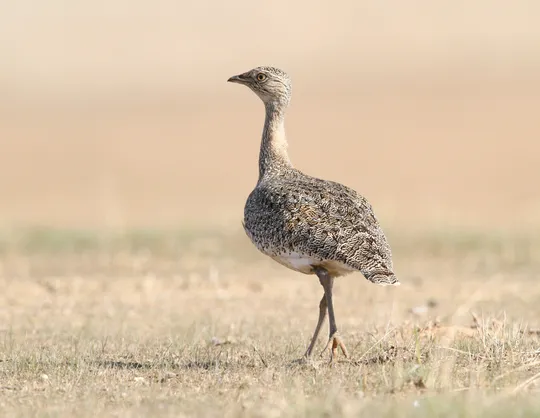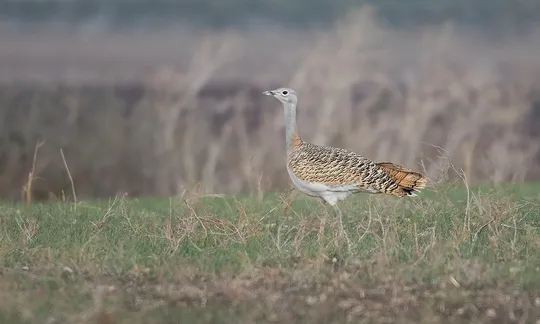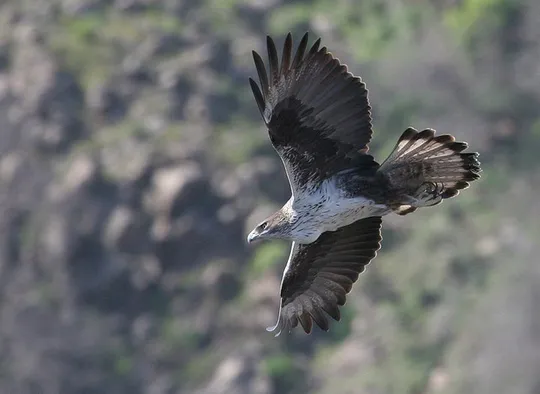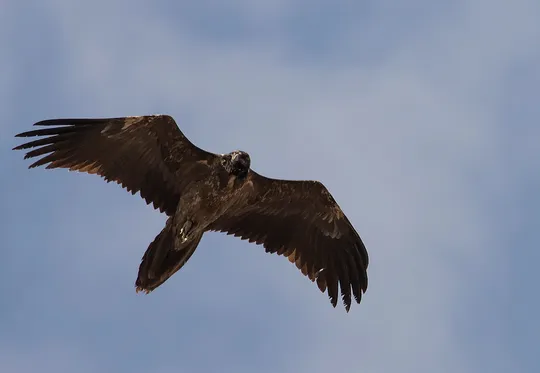Chlamydotis macqueeni
 Endangered
Endangered
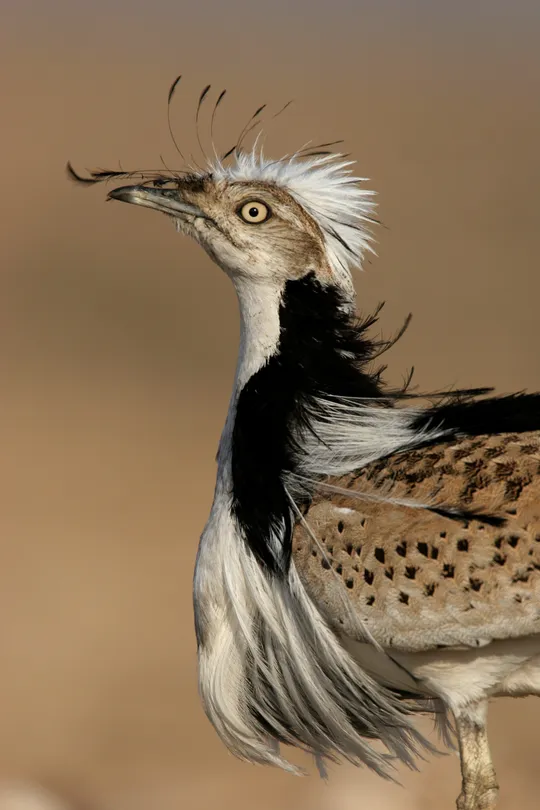
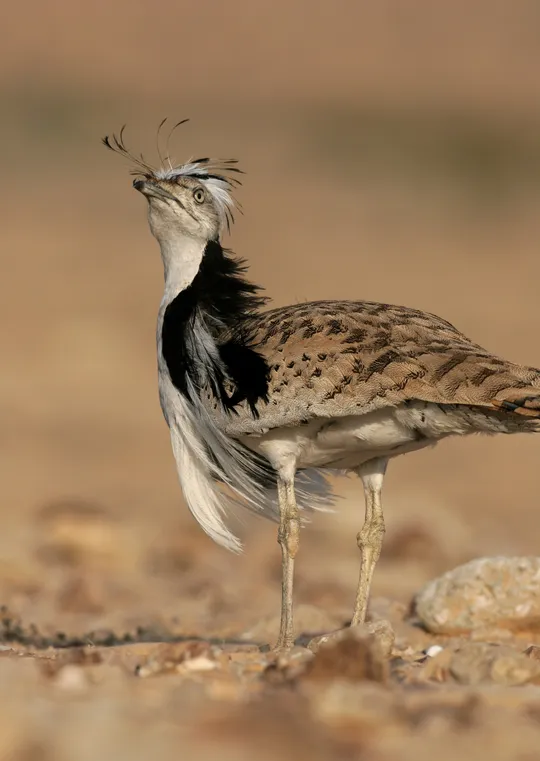
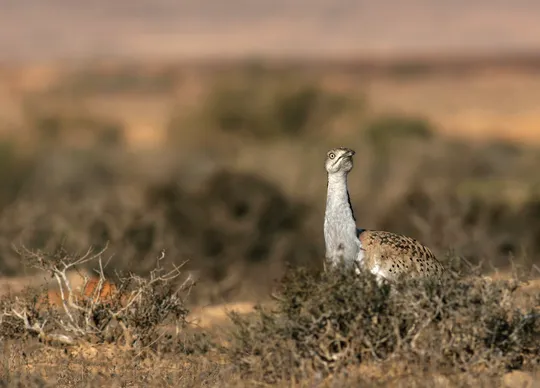
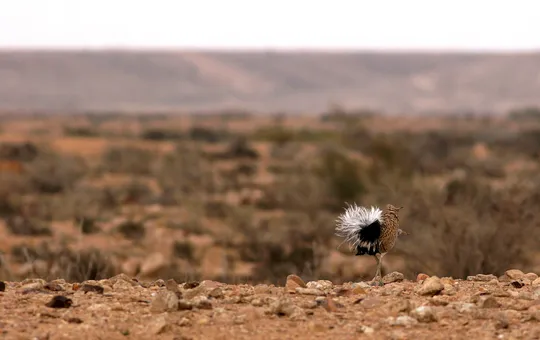
| Habitats | Desert Plains, Inland Sand Dunes |
|---|---|
| Presence In Israel | Resident |
| Breeding In Israel | Breeder |
| Migration Types | Resident, Nomad |
| Zoographical Zones | Irano-Turanian, Saharo-Arabian |
| Landscape Types | Plains & Valleys, Wide Wadis, Sand Dunes |
| Vegetation Types | Steppe, Herbaceous |
| Vegetation Densities | Low |
| Nest Locations | Ground |
| Diet Types | Generalist |
| Foraging Grounds | Ground |
| Body Sizes | Large (over 1000g) |
| Threat Factors | Electrocution and collision with transmission wires, Overgrazing, Pesticide Poisoning, Habitat loss and fragmentation, Tree planting |
The Asian Houbara is a large stocky cumbersome ground-nesting bird, with long legs and neck. Its cryptic plumage is brown-gray, with a pronounced black stripe along the sides of its neck and large yellow eyes. When in flight it reveals a prominent black and white pattern on its wings. During most of the year, the Asian Houbara is a quiet, wary bird, but during the mating season, the males perform a unique impressive courtship display. It is omnivorous and inhabits desert and semi-desert areas.
The Asian Houbara is a rare resident in the Western Negev, and the Southern Negev. Until the early 20th century it was common in all the desert and steppe flatlands in Israel, including most of the Negev, the Jordan Valley and the Judean Lowlands, north up to the Ramle area. During the British Mandate, its range decreased due to hunting, and by the late 1940s, it disappeared completely from the Jordan Valley and the Judean Lowlands. During the 1980s, the Negev population increased, probably because of the ban on hunting and closure of IDF training grounds. However, at the same time the species receded from the Judean Desert highlands, the Eastern Negev and the Arava. During the last two decades, the number of individuals and range size in the Negev have decreased, probably because of development and expansion of inhabited and cultivated areas, as well as overgrazing by sheep and goat herds, and disturbance by shepherding dogs.
The Asian Houbara inhabits open areas in Israel’s desert and steppe regions. It prefers soft hills, wide wadis and flatlands with sparse vegetation, as well as sand dunes and hamadas with scattered shrubs. Occasionally attracted to cultivated areas and stubble fields (particularly outside the breeding season).
Habitat modification and destruction – extensive areas in the Northern Negev have undergone drastic change in recent decades, including expansion of settlements in the Be’er Sheva Valley and the Western Negev, and establishment of permanent settlements for the Bedouin population. Moreover, natural areas have been afforested, and open fields have been converted to greenhouses. These factors have reduced the Asian Houbara suitable habitats and led to the expansion of natural predator populations (crows, jackals and foxes).
Direct disturbance – mainly by grazing, military and off-road vehicle activity. This is probably the main reason for Asian Houbara concentrations inside fenced areas such as the Hatserim Air Force Base.
Poaching – Asian Houbaras are exposed to illegal hunting, both in Israel and in neighboring countries where the birds wander.
Collisions with power lines – Bustards (Otididae) are extremely sensitive to collision with overhead power lines. In recent years, there is evidence of a number of collision incidents with power lines in the Nitsana-Shivta region.
No specific conservation measures have been taken for this species to date. In the Jordanian side of the Arava Valley, hundreds of Asian Houbaras from breeding nuclei in Abu Dhabi and the Gulf States have been released in recent years. Some of these birds cross into Israel and are seen mainly in cultivated areas along the Arava. These birds are not wary of people, and most of them apparently do not survive in nature, but according to a number of observations, a small portion of them are integrating into the breeding population and are reproducing.
The Asian Houbara is classified as endangered because of the continued decline in its population and range. Although considerable portions of Asian Houbara habitats in Israel are declared nature reserves or national parks (such as the "Loess Park" near Beer Sheva) they are not optimal nesting areas, mainly because of extensive vehicle and livestock traffic during the breeding season. A conservation program for the species should be prepared.
Preservation of key natural habitats in the Northern and Western Negev, including nesting areas in the Nitsana-Shivta area, corridors in the Western Negev sands and summering areas in the Hatserim-Tse’elim region. These key areas should be managed in line with the requirements of Asian Houbaras and other ground-nesting species, according to a specific conservation program.
Grazing in the Western Negev should be restricted during the breeding season. Grazing disturbance includes nest trampling by livestock and predation by sheepdogs accompanying the herds. Therefore, the size of the herds and the number of dogs should be limited in important Houbara areas.
Afforestation on loess plains in the Hatserim-Tse’elim region should be halted and existing planted areas should be rehabilitated.
- אסולין, ר., ביסמוט, ג. וצוער, א. 2016. תוצאות ספירת חוברות בנגב 2016 וסיכום מגמות באוכלוסייה. דו"ח רשות הטבע והגנים.
- מירוז, א. והצופה, א. 2003. תפוצת קינון ודגם ניצול שטח של החובארה במערב הנגב. העזניה 30, הוצאת טבע הדברים והחברה להגנת הטבע.
- פז, ע. 1986. עופות. מתוך אלון, ע. (עורך), החי והצומח של ארץ ישראל. כרך 6. הוצאת משרד הביטחון, ישראל.
- פרלמן, י., אלתרמן, ש. וגרניט, ב. 2011. סקר עופות דוגרים בנחלים הפנימיים, אביב 2011. דו"ח מרכז הצפרות של החברה להגנת הטבע.
- פרלמן, י., שוחט, א. ולבינגר, ז. 2009. סקר אטלס ציפורים בערבה סיכום שנת 2009. דו"ח מרכז הצפרות של החברה להגנת הטבע.
- Perlman, Y., Shochat, E. and Labinger, Z. 2011. Developing Managment plan for important bird areas in southern Israel. second annual report, Nizzana region and Arava Valley.Israeli Ornithological center, SPNI.
- Shirihai, H., 1996. The Birds of Israel. Academic Press, London.
- Symes, A. 2013. Species generation lengths. Unpublished, BirdLife International.
- Species page at Birdlife International
Current Occupancy Map
| Data Missing | Sporadic | Limited Sites | Low Density | High Density |
|---|---|---|---|---|
| 0 | 0 | 0 | 0 | 0 |
Distribution maps
The maps presented here provide visual information on the distribution of species in Israel from the past and present, and the changes in occupancy and breeding density during the comparison period. For further reading
Relative Abundance 2010-2020
Breeding density values in the current decade as determined from experts' opinion and observations from databases.
| Data Missing | Sporadic | Limited Sites | Low Density | High Density |
|---|---|---|---|---|
| 8 | 12 | 12 | 21 | 19 |
Relative Abundance 1980-1990
Density values based primarily on the book The Birds of Israel (Shirihai 1996).
| Data Missing | Sporadic | Limited Sites | Low Density | High Density |
|---|---|---|---|---|
| 5 | 14 | 14 | 17 | 22 |
Occupancy 1990-2020
The map shows differences in the species breeding distribution between the 1980's breeding map and the current weighted breeding evaluation. Negative value - species previously bred in the grid and is not presently breeding; positive value - species has not previously bred in the grid and is currently breeding.
| Data Missing | No Change | Occupancy Increase | Occupancy Decrease |
|---|---|---|---|
| 6 | 35 | 1 | 9 |
Change in Relative Abundance 1990-2020
The map shows the changes in the relative abundance of a species in each of the distribution grids between the breeding map of the 1980s and the weighted current breeding evaluation. Negative values - decline in abundance; positive values - increase in abundance; zero - no change in abundance.
| 80 to 100 | 50 | 20 to 30 | No Change | 30- to 20- | 50- | 100- to 80- | Data Missing |
|---|---|---|---|---|---|---|---|
| 0 | 4 | 2 | 22 | 12 | 14 | 11 | 16 |
| Rarity | |
|---|---|
| Vulnerability | |
| Attractiveness | |
| Endemism | |
| Red number | |
| Peripherality | |
| IUCN category | |
| Threat Definition according to the red book |
 Contributed:
Contributed: 